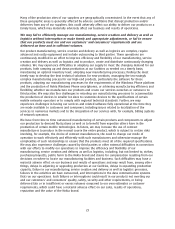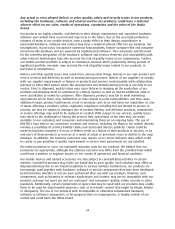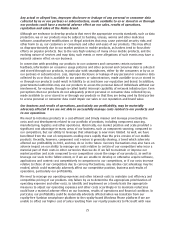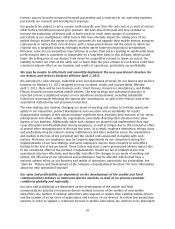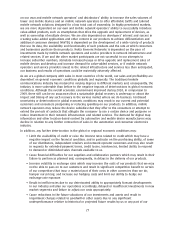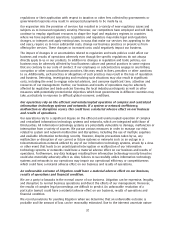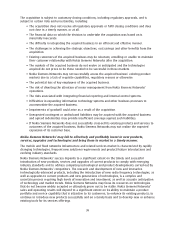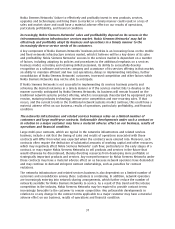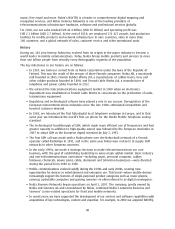Nokia 2010 Annual Report Download - page 33
Download and view the complete annual report
Please find page 33 of the 2010 Nokia annual report below. You can navigate through the pages in the report by either clicking on the pages listed below, or by using the keyword search tool below to find specific information within the annual report.regulations or their application with respect to taxation or other fees collected by governments or
governmental agencies may result in unexpected payments to be made by us.
Our expansion into the provision of services has resulted in a variety of new regulatory issues and
subjects us to increased regulatory scrutiny. Moreover, our competitors have employed and will likely
continue to employ significant resources to shape the legal and regulatory regimes in countries
where we have significant operations. Legislators and regulators may make legal and regulatory
changes, or interpret and apply existing laws, in ways that make our services less appealing to the
end users, require us to incur substantial costs, change our business practices or prevent us from
offering the services. These changes or increased costs could negatively impact our business.
The impact of changes in or uncertainties related to regulation and trade policies could affect our
business and results of operations adversely even though the specific regulations do not always
directly apply to us or our products. In addition to changes in regulation and trade policies, our
business may be adversely affected by local business culture and general practices in some regions
that are contrary to our code of conduct. If our employees or subcontractors engage in any bribery,
corruption or other unsound business practices, this may result in fines, penalties or other sanctions
to us. Additionally, such practices or allegations of such practices may result in the loss of reputation
and business. Detecting, investigating and resolving such situations may also result in significant
costs, including the need to engage external advisors, and consume significant time, attention and
resources of our management. Further, our business and results of operations may be adversely
affected by regulation and trade policies favoring the local industry participants as well as other
measures with potentially protectionist objectives which host governments in different countries may
take, particularly in response to difficult global economic conditions.
Our operations rely on the efficient and uninterrupted operation of complex and centralized
information technology systems and networks. If a system or network inefficiency,
malfunction or disruption occurs, this could have a material adverse effect on our business
and results of operations.
Our operations rely to a significant degree on the efficient and uninterrupted operation of complex
and centralized information technology systems and networks, which are integrated with those of
third parties. All information technology systems are potentially vulnerable to damage, malfunction or
interruption from a variety of sources. We pursue various measures in order to manage our risks
related to system and network malfunction and disruptions, including the use of multiple suppliers
and available information technology security. However, despite precautions taken by us, any
malfunction or disruption of our current or future systems or networks such as an outage in a
telecommunications network utilized by any of our information technology systems, attack by a virus
or other event that leads to an unanticipated interruption or malfunction of our information
technology systems or networks could have a material adverse effect on our business and results of
operations. Furthermore, any data leakages resulting from information technology security breaches
could also materially adversely affect us. Also, failures to successfully utilize information technology
systems and networks in our operations may impair our operational efficiency or competitiveness
which could have a material adverse effect on our business and results of operations.
An unfavorable outcome of litigation could have a material adverse effect on our business,
results of operations and financial condition.
We are a party to lawsuits in the normal course of our business. Litigation can be expensive, lengthy,
and disruptive to normal business operations and divert the efforts of our management. Moreover,
the results of complex legal proceedings are difficult to predict. An unfavorable resolution of a
particular lawsuit could have a material adverse effect on our business, results of operations and
financial condition.
We record provisions for pending litigation when we determine that an unfavorable outcome is
probable and the amount of loss can be reasonably estimated. Due to the inherent uncertain nature
32



